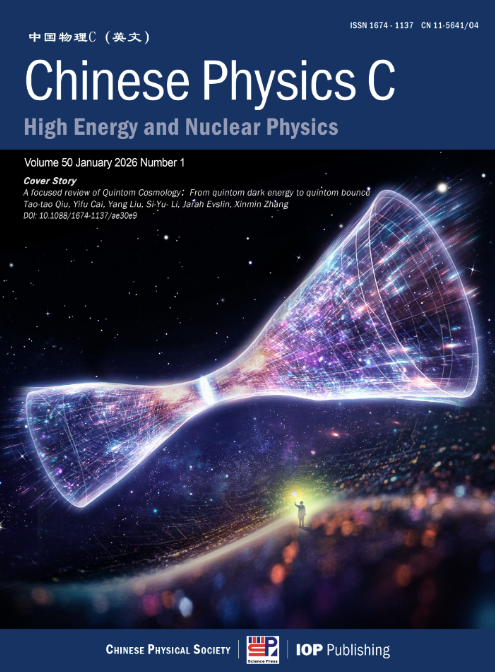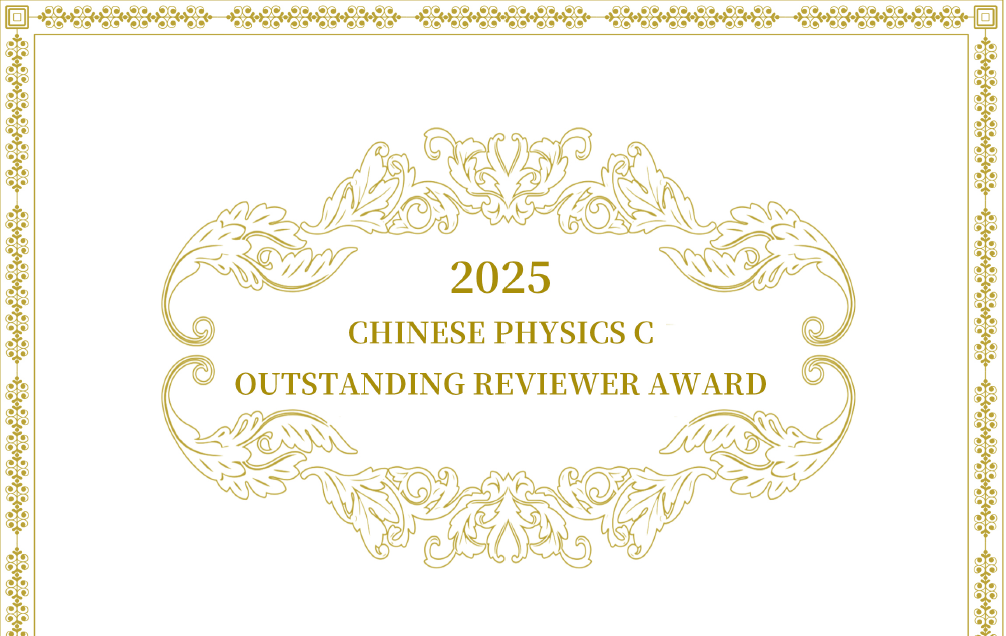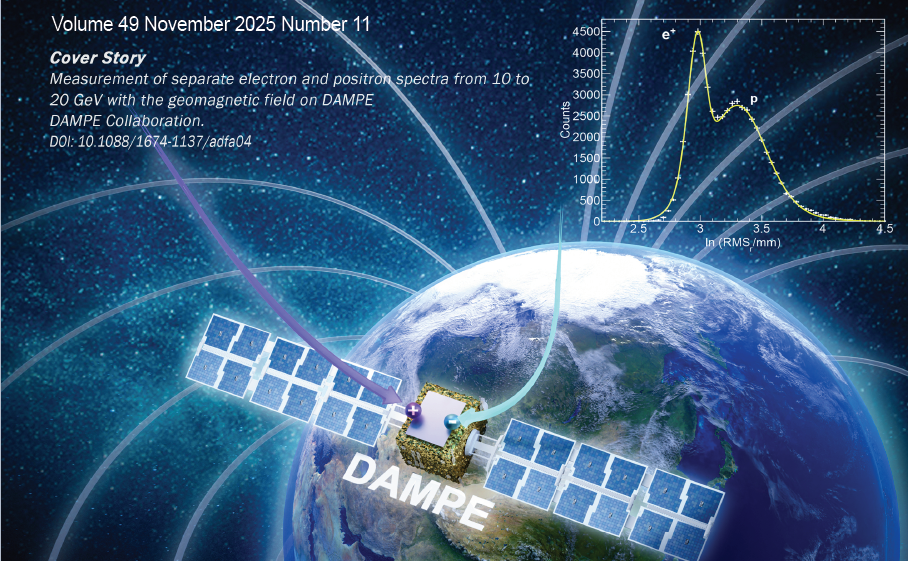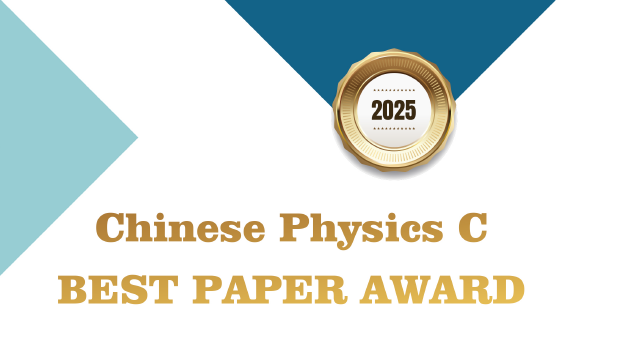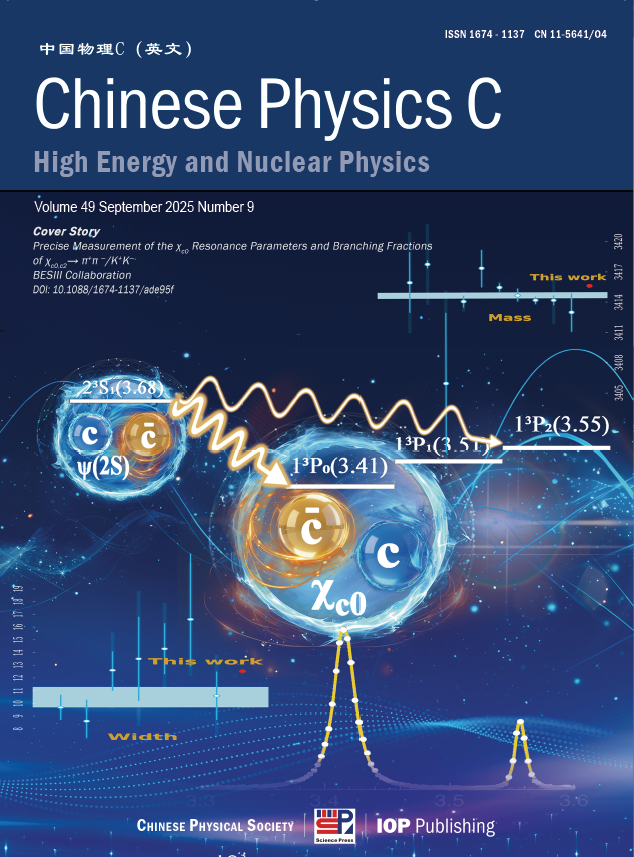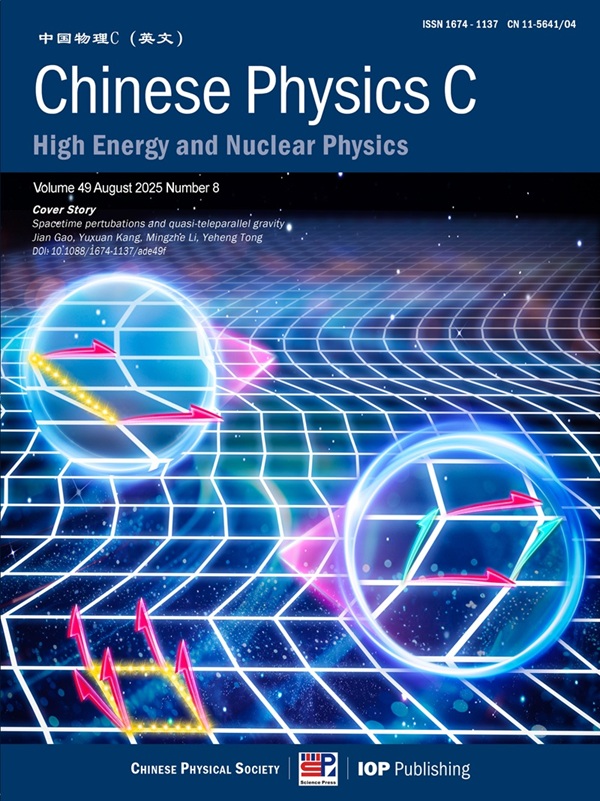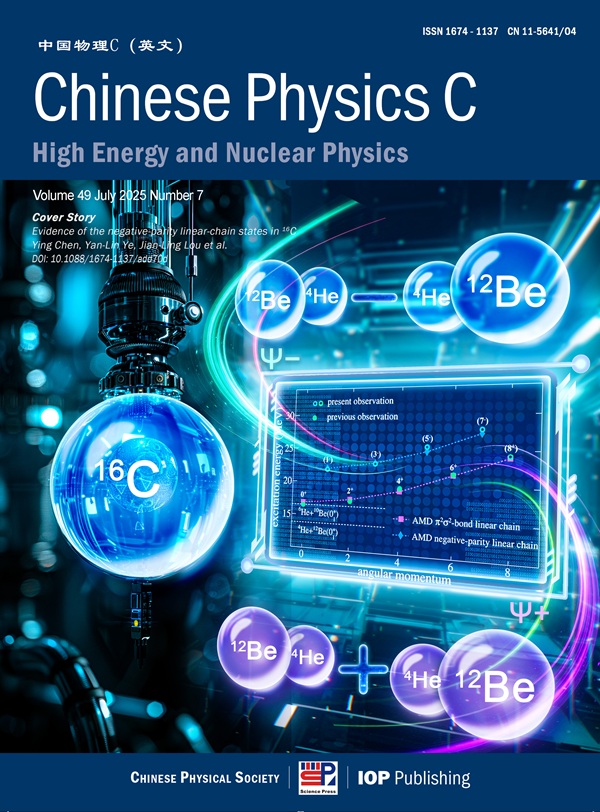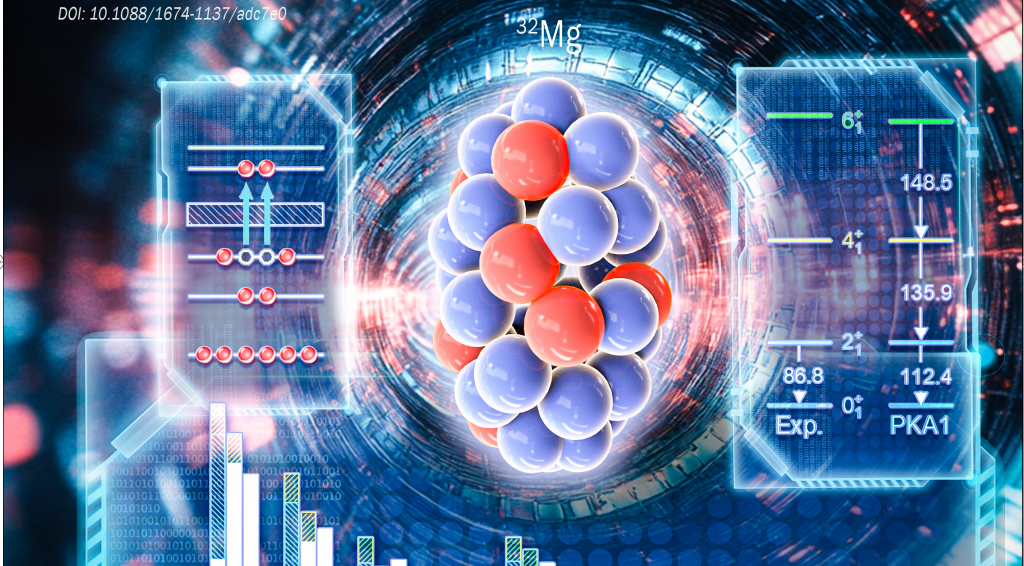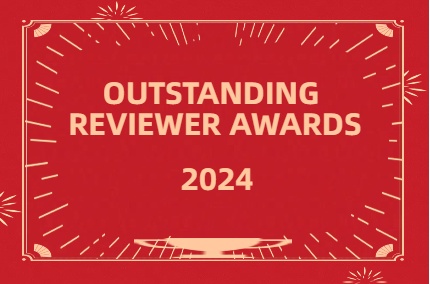Highlights
-
Tilted-axis-cranking covariant density functional theory for high-spin spectroscopy of 69Ga
2026, 50(1): 014112. doi: 10.1088/1674-1137/ae07b8
 The tilted-axis-cranking covariant density functional theory is applied to investigate the three newly-observed positive-parity bands SI, SII, and SIII in 69Ga. The energy spectra and angular momenta are calculated, and they agree closely with experimental data. For band SI, pairing correlations are crucial for the states with spin $I\leq 23/2\hbar$. Bands SII and SIII are suggested to be signature partner bands with positive and negative signatures, respectively. By analyzing the angular momentum alignments, we reveal that the $g_{9/2}$ protons and neutrons are crucial in the collective structures of 69Ga. The transition probabilities $B(E2)$ for these bands are predicted, awaiting further experimental verification.
The tilted-axis-cranking covariant density functional theory is applied to investigate the three newly-observed positive-parity bands SI, SII, and SIII in 69Ga. The energy spectra and angular momenta are calculated, and they agree closely with experimental data. For band SI, pairing correlations are crucial for the states with spin $I\leq 23/2\hbar$. Bands SII and SIII are suggested to be signature partner bands with positive and negative signatures, respectively. By analyzing the angular momentum alignments, we reveal that the $g_{9/2}$ protons and neutrons are crucial in the collective structures of 69Ga. The transition probabilities $B(E2)$ for these bands are predicted, awaiting further experimental verification. -
Null test of cosmic curvature using deep learning method
2026, 50(1): 015107. doi: 10.1088/1674-1137/ae0b42
 Determining the spatial curvature of the Universe, a fundamental parameter defining the global geometry of spacetime, remains crucial yet contentious due to existing observational tensions. Although Planck satellite measurements have provided precise constraints on spatial curvature, discrepancies persist regarding whether the Universe is flat or closed. Here, we introduce a model-independent approach leveraging deep learning techniques, specifically residual neural networks (ResNet), to reconstruct the dimensionless Hubble parameter E(z) and the normalized comoving distance D(z) from H(z) data and multiple SNe Ia compilations. Our dual-block ResNet architecture, which integrates a model-driven block informed by $ \Lambda $CDM and a purely data-driven block, yields smooth and robust reconstructions and enables the derivation of D'(z). By combining these reconstructed quantities, we assess the curvature diagnostic function $ {\cal{O}}_k(z) $. Analyses of the Pantheon+ sample support spatial flatness at the 1$ \sigma $ level over 0 < z < 2.5, with a mild tendency toward negative curvature at high redshift. Reconstructions based on Union3 and DESY5, however, show stronger departures toward negative curvature at intermediate and high redshifts. These results highlight the need for expanded and refined observational datasets to conclusively resolve these tensions and comprehensively investigate cosmic geometry.
Determining the spatial curvature of the Universe, a fundamental parameter defining the global geometry of spacetime, remains crucial yet contentious due to existing observational tensions. Although Planck satellite measurements have provided precise constraints on spatial curvature, discrepancies persist regarding whether the Universe is flat or closed. Here, we introduce a model-independent approach leveraging deep learning techniques, specifically residual neural networks (ResNet), to reconstruct the dimensionless Hubble parameter E(z) and the normalized comoving distance D(z) from H(z) data and multiple SNe Ia compilations. Our dual-block ResNet architecture, which integrates a model-driven block informed by $ \Lambda $CDM and a purely data-driven block, yields smooth and robust reconstructions and enables the derivation of D'(z). By combining these reconstructed quantities, we assess the curvature diagnostic function $ {\cal{O}}_k(z) $. Analyses of the Pantheon+ sample support spatial flatness at the 1$ \sigma $ level over 0 < z < 2.5, with a mild tendency toward negative curvature at high redshift. Reconstructions based on Union3 and DESY5, however, show stronger departures toward negative curvature at intermediate and high redshifts. These results highlight the need for expanded and refined observational datasets to conclusively resolve these tensions and comprehensively investigate cosmic geometry. -
Extracting the kinetic freeze-out properties of high energy pp collisions at the LHC with event shape classifiers
2026, 50(1): 014108. doi: 10.1088/1674-1137/ae07ba
 Event shape measurements are crucial for understanding the underlying event and multiple-parton interactions (MPIs) in high energy proton-proton (pp) collisions. In this study, the Tsallis blast-wave model with independent non-extensive parameters for mesons and baryons was applied to analyze the transverse momentum spectra of charged pions, kaons, and protons in pp collision events at $ \sqrt{s}=13 $ TeV classified by event shape estimators such as relative transverse event activity, unweighted transverse spherocity, and flattenicity. Our analysis reveals consistent trends in the kinetic freeze-out temperature and non-extensive parameter across different collision systems and event shape classes. The use of diverse event-shape observables in pp collisions has significantly expanded the accessible freeze-out parameter space, enabling a more comprehensive exploration of its boundaries. Among these event shape classifiers, flattenicity emerges as a unique observable for disentangling hard process contributions from additive MPI effects, which helps isolate collective motion effects encoded by the radial flow velocity. Through the analysis of the interplay between event-shape measurements and kinetic freeze-out properties, we gain deeper insights into mechanisms responsible for flow-like signatures in pp collisions.
Event shape measurements are crucial for understanding the underlying event and multiple-parton interactions (MPIs) in high energy proton-proton (pp) collisions. In this study, the Tsallis blast-wave model with independent non-extensive parameters for mesons and baryons was applied to analyze the transverse momentum spectra of charged pions, kaons, and protons in pp collision events at $ \sqrt{s}=13 $ TeV classified by event shape estimators such as relative transverse event activity, unweighted transverse spherocity, and flattenicity. Our analysis reveals consistent trends in the kinetic freeze-out temperature and non-extensive parameter across different collision systems and event shape classes. The use of diverse event-shape observables in pp collisions has significantly expanded the accessible freeze-out parameter space, enabling a more comprehensive exploration of its boundaries. Among these event shape classifiers, flattenicity emerges as a unique observable for disentangling hard process contributions from additive MPI effects, which helps isolate collective motion effects encoded by the radial flow velocity. Through the analysis of the interplay between event-shape measurements and kinetic freeze-out properties, we gain deeper insights into mechanisms responsible for flow-like signatures in pp collisions.
Just Accepted
More >
-
Black holes immersed in modified Chaplygin-like dark fluid and cloud of strings: shadows, quasinomal modes and greybody factors
Published: 2026-01-08
-
Asymmetric thin-shell wormholes in the Kalb-Ramond background: Observational characteristics and extra photon rings
Published: 2026-01-07
-
Fully strange tetraquark states via QCD sum rules
Published: 2026-01-07
Recent
More >
-
Gravitational waves from equatorially eccentric extreme mass ratio inspirals around swirling-Kerr black holes
2026, 50(2): 025107-025107-11. doi: 10.1088/1674-1137/ae1afcShow AbstractThe swirling-Kerr black hole is a novel solution of vacuum general relativity and has an extra swirling parameter characterizing the rotation of spacetime background. We study the gravitational waves generated by extreme mass ratio inspirals (EMRIs) along eccentric orbits on the equatorial plane in this novel swirling spacetime. Our findings indicate that this swirling parameter leads to a delayed phase shift in the gravitational waveforms. Furthermore, we investigate the effects of the swirling parameter on the potential issue of waveform confusion caused by the orbital eccentricity and semi-latus rectum parameters. As the swirling parameter increases, the relative variations in the eccentricity increase, whereas the variations in the semi-latus rectum rapidly decrease. The trends related to changes in the orbital eccentricity and semi-latus rectum with the swirling parameter resemble those observed with the MOG parameter in Scalar-Tensor-Vector-Gravity (STVG) theory but with different rates of change. Furthermore, our results also reveal that the effects of the background swirling parameter on the relative variations in the eccentricity and semi-latus rectum are distinct from those of the black hole spin parameter. These results provide deeper insights into the properties of EMRI gravitational waves and background swirling.
-
Bayesian-optimized CatBoost for ground-state nuclear charge-radius prediction
2026, 50(2): 024109-024109-13. doi: 10.1088/1674-1137/ae19dcShow AbstractUnderstanding nuclear shape, behavior, and stability, as well as improving nuclear models, depends on the precise determination of ground-state nuclear charge radii. Existing experimental techniques are limited to extremely narrow regions of the nuclear chart; theoretical models, including relativistic Hartree-Bogoliubov (RHB) and Hartree-Fock-Bogoliubov (HFB), predict broad trends of nuclear properties but miss fine isotopic features such as odd-even staggering effects and shell-closure kinks. High computational time and cost are other obstacles to theoretical approaches. Although machine-learning algorithms have made significant progress in predicting charge radii, they are still hindered by a lack of balanced data and characteristics, primarily centered around $ A\ge40 $ and $ Z\ge20 $. In the present study, we present the first application of CatBoost regression to compute nuclear charge radii. We integrated two experimental datasets with RHB-calculated point-coupling interaction (PC-X) theoretical features and extended our study range to $ A\ge17 $, $ Z\ge8 $. We found the best hyperparameters using Optuna’s Tree-structured Parzen Estimator (TPE) sampler with 10-fold cross-validation (CV), achieving a CV root-mean-square error (RMSE) of 0.0106 fm and hold-out RMSE of 0.0102 fm, with only three features, i.e., neutron number (N), proton number (Z), and RHB theoretical binding energy (BE), outperforming nine other ML models: random forest (RF), quantile RF (QRF), Cubist, Gaussian process regression with polynomial kernel (GPPK), multivariate adaptive regression splines (MARS), SVR, ANN, convolutional neural network (CNN), and Brussels-Skyrme-on-a-grid 3 (BSkG3). SHapley Additive exPlanations (SHAP) analysis confirms the highest global influence of BE in the model's predictions, followed by proton number and neutron number. The proposed model can accurately reproduce the $ N=50 $ kink and odd-even staggering effects in krypton and strontium chains. These results establish CatBoost as a robust and notably promising model for charge-radius prediction and beyond, with the potential to impact r-process modeling and future theoretical development.
-
Investigation of resonances in the Σ(1/2–) system based on the chiral quark model
2026, 50(2): 023109-023109-11. doi: 10.1088/1674-1137/ae18afShow AbstractIn this work, we investigate the resonance structures in the $ \Sigma(1/2^-) $ system from both three-quark and five-quark perspectives within the framework of the chiral quark model. An accurate few-body computational approach, the Gaussian expansion method, is employed to construct the orbital wave functions of multiquark states. To reduce the model dependence on parameters, we fit two sets of parameters to check the stability of the results. The calculations show that our results remain stable despite changes in the parameters. In the three-quark calculations, two $ \Sigma(1/2^-) $ states are obtained with energies around 1.8 GeV, which are good candidates for the experimentally observed $ \Sigma(1750) $ and $ \Sigma(1900) $. In the five-quark configuration, several stable resonance states are identified, including $ \Sigma \pi $, $ N \bar{K} $, and $ N \bar{K}^{*} $. These resonance states survive the channel-coupling calculations under the complex-scaling framework and manifest as stable structures. Our results support the existence of a two-pole structure for the $ \Sigma(1/2^-) $ system, predominantly composed of $ \Sigma \pi $ and $ N \bar{K} $ configurations, analogous to the well-known $ \Lambda(1380) $-$ \Lambda(1405) $ ($ \Sigma \pi $-$ N \bar{K} $) system. On the other hand, although the energy of the $ N \bar{K}^{*} $ configuration is close to that of $ \Sigma(1750) $ and $ \Sigma(1900) $, the obtained width is not consistent with the experimental values. This suggests that the $ N \bar{K}^{*} $ state needs to mix with three-quark components to better explain the experimental $ \Sigma(1750) $ and $ \Sigma(1900) $ states. According to our decay width calculations, the predicted two resonance states are primarily composed of $ \Sigma \pi $ and $ N \bar{K} $, with their main decay channel being $ \Lambda \pi $. Therefore, we encourage experimental groups to search for the predicted two-pole structure of the $ \Sigma(1/2^-) $ system in the invariant mass spectrum of $ \Lambda \pi $.
Archive
ISSN 1674-1137 CN 11-5641/O4
Original research articles, Ietters and reviews Covering theory and experiments in the fieids of
- Particle physics
- Nuclear physics
- Particle and nuclear astrophysics
- Cosmology
Author benefits
- A SCOAP3 participating journal - free Open Access publication for qualifying articles
- Average 24 days to first decision
- Fast-track publication for selected articles
- Subscriptions at over 3000 institutions worldwide
- Free English editing on all accepted articles
News
- CPC Announces 2025 Outstanding Reviewers
- Chinese Physics C Outstanding Reviewer Award 2023
- Impact factor of Chinese Physics C is 3.6 in 2022
- 2022 CPC Outstanding Reviewer Awards
- The 2023 Chinese New Year-Office closure
Cover Story
- Cover Story (Issue 1, 2026) A focused review of quintom cosmology: from quintom dark energy to quintom bounce
- Cover Story (Issue 11, 2025) The Earth-Magnet Assists DAMPE in Studying Cosmic Anti-Electrons
- Cover Story (Issue 9, 2025): Precise measurement of χc0 resonance parameters and branching fractions of χc0,c2→π+π-/ K+K-
- Cover Story (Issue 8, 2025) A Novel Perspective on Spacetime Perturbations: Bridging Riemannian and Teleparallel Frameworks
- Cover Story (Issue 7, 2025) Evidence of the negative parity linear chain states in 16C





